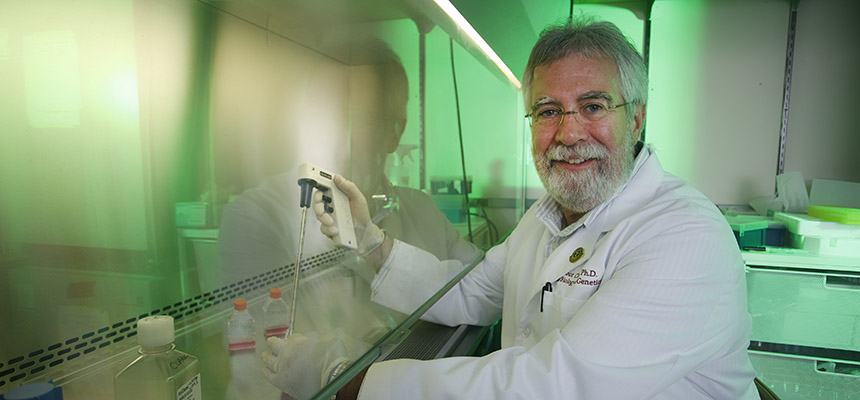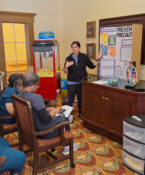Twenty years of teamwork, then a glaucoma breakthrough

More than two decades of teamwork between researchers at the University of Iowa and UNT Health Science Center has led to a breakthrough for treating a type of glaucoma that damages the eyesight of millions and can cause irreversible vision loss.
The research focuses on myocilin, a protein implicated in both juvenile and adult-onset open-angle glaucoma, which affects about 2 million people worldwide.
Using CRISPR technology, a revolutionary genome-editing tool that can alter DNA sequences and modify gene function, researchers were able to eliminate myocilin and lower intraocular pressure to prevent further damage to the eye, said Abe Clark, PhD, Regents Professor and Executive Director of the North Texas Eye Research Institute at UNT Health Science Center.
“Using this technology, we were able to knock out the myocilin gene in mice, and we prevented a type of glaucoma,” Dr. Clark said. “We also looked at whether we could intervene after the mice have already had damage, and we were partially able to prevent further damage.”
The research is published online in the Oct. 2 issue of Proceedings of the National Academy of Science or PNAS, the official journal of the National Academy of Sciences. Scientists from the University of Iowa, UNT Health Science Center and the Massachusetts Institute of Technology collaborated on the study.
Myocilin is a protein found in structures within the eye called the trabecular meshwork, which regulates pressure. Glaucoma can develop when a mutation in myocilin affects the trabecular meshwork and causes elevated intraocular pressure.
Researchers showed that by disrupting the mutant myocilin gene using CRISPR-Cas 9 technology, they were able to reduce intraocular pressure and prevent further damage in mouse eyes. They also showed the feasibility of using the CRISP-Cas9 system in cultured human eyes.
Glaucoma affects 70 to 80 million people worldwide. Mutant myocilin is responsible for about 4 percent of cases, equivalent to more than 2 million people. Mutations in the myocilin gene have been shown to cause juvenile open-angle glaucoma as well as adult primary open-angle glaucoma.
The discovery is made even more significant because it is the first example of using CRISPR genome editing technology to treat a major intraocular disease, Dr. Clark said. The CRISPR/Cas9 technology allows for site-specific genomic targeting.
The breakthrough is the result of more than 20 years of collaboration between scientists at the University of Iowa Carver College of Medicine and UNT Health Science Center. A researcher at the McGovern Institute for Brain Research at the Massachusetts Institute of Technology also contributed to the study.
UNTHSC and the University of Iowa have been working on eye research projects together since 1993.
“The University of Iowa mapped this first glaucoma gene and I thought that I could help them identify it,” said Dr. Clark, a longtime glaucoma researcher. “I called up and asked if I could visit, and our collaboration just took off from there.”
The meeting turned into a friendship and collaboration that has endured between Dr. Clark and Val C. Sheffield, MD, PhD, Carver Chair of Medical Genetics, Professor of Pediatrics and Ophthalmology and Investigator of the Wynn Institute for Vision Research at the University of Iowa.
Over time an intellectual pipeline evolved between the two universities. The study illustrates the importance of this pipeline perfectly.
The primary first author of this publication is Ankur Jain, PhD, who graduated from Dr. Clark’s lab at UNTHSC three years ago and is now doing his postdoc work with Dr. Sheffield at Iowa. Second author is Gulab Zode, PhD, who graduated from UNTHSC, did his postdoc in the Sheffield lab at Iowa and then returned to UNTHSC as an Assistant Professor. Tasneem Sharma, PhD, was a graduate student in the Clark lab at UNTHSC and went to work in Dr. John Fingert’s lab in Iowa before returning to UNTHSC.
Dr. Clark said that the key to the long relationship is how much respect the researchers have for each other. It’s a good example of collaborative science, he said.
“It’s a nice way to demonstrate that science done in one lab doesn’t have to have all the answers,” he said. “When we work together, there is a lot of synergy going that gets us all a lot further in our research.”

![Uyen Sa Nguyen Scaled[58]](https://www.unthsc.edu/newsroom/wp-content/uploads/sites/16/Uyen-Sa-Nguyen-scaled58-145x175.jpg)



Social media